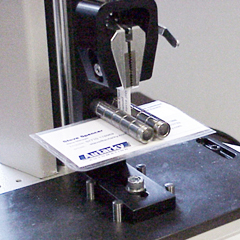
Products with bonded layers such as laminated security or ID cards undergo peel testing to check the integrity of the adhesive attaching the coating. Businesses in the home and office sector or manufacturers within the adhesives and coatings industries should quality test to these standards. A 90 degree peel test is applicable for samples where a more flexible bonded layer is pulled off a stiffer substrate at a right angle in order to determine the minimum force to peel the laminate. The test equipment must ensure that the 90 degree pull angle is maintained, with the substrate remaining horizontal and travelling laterally by means of a floating roller fixture or a moving peel table. The rigid substrate may negate the need for the support of a table, as in the case of a laminated ID or credit card. Flat jawed wedge or vice grips are needed to securely hold the coating layer throughout its vertical movement.
Mecmesin Systems: MultiTest motorised test system
Case Study: Delamination peel test

The foil lid of blister packaging must allow separation in normal use by means of peeling the flexible layer from the formed container without tearing. The adhesive strength of the bond should facilitate this ease of opening and also guarantee the reliable sealing of the product within, which may be a liquid or gel with hygiene or sterility requirements in the pharmaceutical or food industries. Peel testing of these packages to external or internal standards has several challenges in order to replicate the actual manner in which the elements are separated in service and to repeatably focus the test of the adhesive characteristics of the bond itself. Maintaining the peel angle (initiated at 135 degrees) to within the desired specification may require the design of a custom fixture – a jointed chain can effectively replicate the manner in which a consumer will apply the tension to the lid. Grasping of the corner of the foil in a manner akin to human fingers will require suitably sized pinch grips. In order to focus the test on the bonding around the blister perimeter, the surface needs to be kept flat and in a non-deformed condition, to avoid introducing inaccuracies into the process and ensure repeatability. The use of a pneumatically-activated vacuum fixture specifically moulded to the blister profile is the reliable solution.
Mecmesin Systems: Touch screen force test systems, pinch grip

The testing of adhesive tapes and coatings present challenges for the product manufacturer in any industry, as the procedure itself must test the performance of a thin layer of bonding and often handle a flexible adherend on at least one surface. Peel resistance is the primary type of test for these bonded products and both international industry standards and internal checks demand the secure location of the sample whilst also allowing resistance-free relative movement between the adherends to enable the relevant layer to peel without obstruction. A manufacturer of filters for customers in the tobacco industry has varying specifications for the brands it supplies and the health and safety implications of such products (they are in contact with the mouth) also means that legislation is constantly evolving, with impact upon the manufacturing process and raw materials. The delicacy of the components (cellulose acetate filter and paper coating) requires consideration in the design of test fixtures to quality assure the peel resistance. Four locating dowels mounted on light needle roller bearings ensure that the rotation of the sample is as friction-free as possible and able to float within the fixture, as the paper coating is pulled vertically at a constant rate to unwrap. The locating fixture itself is securely anchored to a modified anvil base plate. This internal test is closely related to the 90 degree peel, floating roller, climbing drum and German peel wheel tests, but has been developed to meet the unique situation of the cigarette in service. Software captures the peak force, or any other measurable attribute that the manufacturer or customer needs.
Mecmesin Systems: Computer-controlled force test systems

All sterile medical devices require validation of their packaging. The flexible sterile barrier must be shown to be effective throughout the product's claimed shelf-life. The integrity of seals and welds is of critical importance and the testing of the bonding strength of these seals is often performed by peel test, the flexible material on both layers necessitating either 180 degree or T-peel. These tests are also relevant to package openability and evaluating the manufacturing processes’ ability to produce consistent seals and the peak force and/or the average force to open the seal may be relevant. Inspection after the test may reveal either the adhesive has failed to adhere to a substrate (adhesive failure), in which case the bond strength has been measured. Conversely if the bond has failed internally (cohesive failure), or the packaging material has delaminated, torn or failed in another manner, then the test has exposed deficiency in the overall specification of the seal. Usually a representative strip is cut across the seal of a standard width and a T-peel is performed. An important consideration in the fixture design may be to mitigate against bending – by supporting the unpeeled portion of the sample at 90 degrees to the peel direction.
Mecmesin Systems: MultiTest console-controlled force test system, lightweight double-action vice grips
Standards: ASTM F-88, EN 868-5
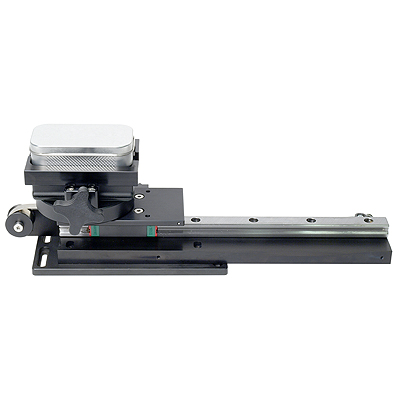
Adhesion quality in post-production packaging labels is a more accurate test than on basic materials, due to deposits on surfaces and from operating environments. Post-production packaging, such as small metal containers, can, however, be awkward to hold during test.
Our client needed to perform a 90 degree peel test on labels applied to small tin lids. Mecmesin designed a dedicated custom grip to hold the tin without distortion, on a moving table peel jig. This ensured correct alignment every time for repeatable testing.

Semi-rigid vacuum-formed packaging, sealed by film or foil, is tested by the 135 degree peel method, to represent hand-pulling. The difficulty for testing is always in mechanical holding of the container. Our client was testing food packaging of a particular design and required a custom solution.
Mecmesin designed and provided a fixture to hold the flexible container in a matched recess by vacuum, at 45 degrees to the test stand column, and to peel from a corner. The film lid was gripped and linked to the crosshead by a chain link to achieve a secure and repeatable test. Vacuum fixtures also allow for rapid throughput of samples for quick and efficient testing.
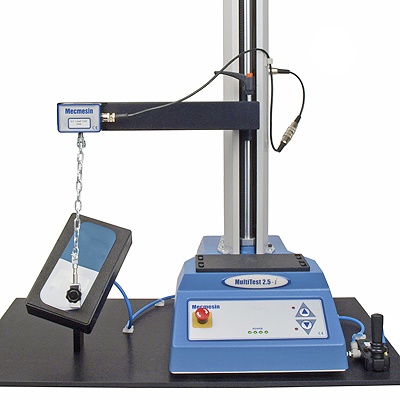
Our client needed to test the peel quality of film lids on semi-rigid pre-filled syringe packs. Inconsistent peeling can result in accidental content spillage, so the force required at a standardised 135 degrees must be measured for a complete opening action. Holding semi-rigid packaging so that it does not deform, requires a custom application for each pack design.
Mecmesin designed and manufactured a vacuum holder for an exact fit to the pack, positioned at the required angle under an extended tensile test arm. The lid was then peeled back with a grip on a flexible chain link. An added advantage of vacuum fixturing is the speed and accuracy of sample changing for maximum throughput and efficiency.

Floating roller peel jigs are available for security card lamination testing, but our client was testing the adhesion of the paper around cigarrette filters. To accommodate the small cylindrical shape required smaller and closer rollers, and a better sample loading design.
Mecmesin responded with customised fixtures for different sizes of filter, employing four roller bars instead of two. Loading samples for repeatable 90 degree peel testing is quick and easy, saving time and cost.
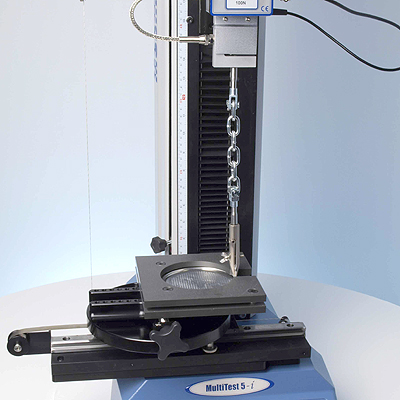
An international supplier of a powdered hot chocolate drink wanted to test several aspects of their plastic-capped, foil-sealed cardboard tube container. This included topload (column crush) of the cardboard, flip-off for the plastic cap and 90 degree peel testing of the metal rim and foil closure element, both removed and in situ.
To enable correct and secure gripping to an assisted peel table, Mecmesin designed a custom jig to hold either the tub base or the top rim closure. The client was then able to use their Mecmesin universal tester for all four tests, with quick and easy exchange of fixtures, and rapid throughput of samples for testing.y.
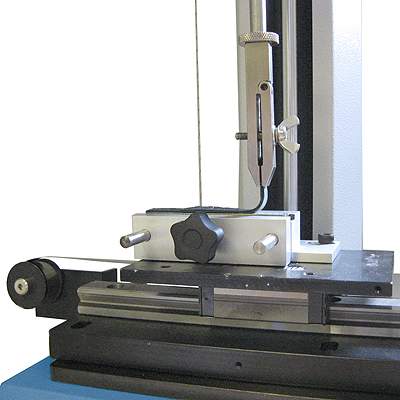
Our client in vehicular upholsery needed to test the peel adhesion strength of leather bonded to metal. A 90 degree peel is straightforward enough, but gripping the metal and leather test sample required a custom vice, mounted on a standard sliding table.
Mecmesin supplied the complete fixturing, including the design and manufacture of a vice to grip the metal substrate from which the adhered leather was to be peeled. Mounting test samples was then very quick and precise, allowing rapid and repeatable testing.
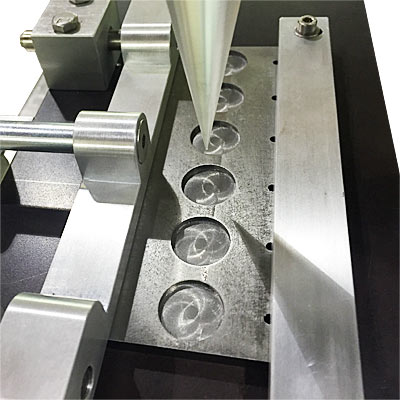
A global chemical company’s R&D laboratory required an improved testing method for the evaluation of adhesive formulations. Internal quality standards necessitated the measurement of tack in viscous adhesive pastes–with the ability to make comparative analyses between multiple samples in a single batch. The procedure also needed to be performed with the glue being sustained at an elevated temperature to simulate real-world environmental conditions. Mecmesin worked with the customer to design a fixture system with six identical circular cross-section sample containment recesses, with integrated heating platen rated to a maximum temperature of 150° C (and able to sustain a constant 120° C for the test itself). The fully programmable computer-controlled UTM is able to load-hold at a constant compressive force for a set time when applying the probe surface to the specimen substrate, then retract at constant speed after the specified dwell time in the adhesive material. This action is repeated number of times to gauge the evolution of the tackiness over multiple contacts. The software analyses the data and performs calculations to return the peak force information for each sample, indicating the tensile strength of the formulation under pull-apart loading. The results are available for each individual specimen, its repetitions and the averaged value for the complete set. This solution provides a consistent methodology for the chemistry lab to implement in back-to-back adhesion testing of products for tack, texture and other attributes which determine ease of application, handling, longevity and ultimate adhesion performance.
Mecmesin Systems: MultiTest computer-controlled force test system,
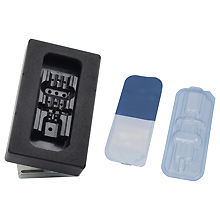
Consumer packaging products where a flexible thin material (such as plastic or aluminium foil) forms a peelable lid, should undergo peel testing. The adhesive bond is formed around a mating surface at the perimeter as seen in the seams and seals of retort pouches or pots for the food industry and medical device packages. The test program must maintain the 90 degree pull angle, with the container remaining horizontal whilst travelling laterally via moving table jig, achieved by mechanically driving the table from the vertical motion of the test stand crosshead. Consideration should be given to securing the container and a bespoke moulded vacuum fixture is recommended, particularly if the quality standards stipulate that deformation should be minimised. Suitable flat-jawed grips are needed to securely grasp the lid throughout its vertical movement.
Mecmesin Systems: MultiTest motorised test system
Case Study: Retort Pouch

Products utilising thin films or foils to form a coating or layer require peel testing to evaluate the integrity of the adhesive bonding of the coating. Components such as flexible displays comprise layers of thin films and substrates. A 90 degree peel test can be performed to quantify the adhesive properties of samples to analyse the effectiveness of different compositions in a manufacturing, educational, or research and development environment. The test equipment must maintain the 90 degree pull angle, with the substrate remaining horizontal, achieved by means of an assisted peel table fixture. Flat jawed wedge or vice grips are needed to securely hold the thin film throughout its vertical movement.
Mecmesin Systems: MultiTest motorised test system
Case Study: Thin Film Peel
Video: Peel Test on a Foil-Sealed Wine Glass